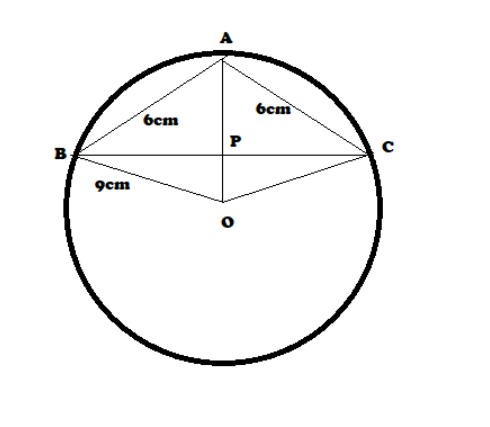Question
Question: If an isosceles triangle ABC in which AB = AC = 6cm is inscribed in a circle of radius 9cm, find the...
If an isosceles triangle ABC in which AB = AC = 6cm is inscribed in a circle of radius 9cm, find the area of the triangle.
Solution
In this question we will use the basic properties of the circle and Pythagoras theorem. Here we will make an isosceles triangle inside a circle of given radius and then by using properties of the circle and Pythagoras theorem we will find out the area of that triangle.
Complete step-by-step answer :

Given that,
In △ABC, AB = AC = 6cm and it is inscribed in a circle having radius 9cm.
Let O be the centre of the circle and P be the midpoint of side BC, then OP⊥BC
Since △ABC is isosceles and p is the mid-point of BC.
Therefore,
AP⊥BC as the median from the vertex in an isosceles triangle is perpendicular to the base.
Let AP = x and PB = CP = y.
Now, applying Pythagoras theorem in △APB, we have
⇒(AB)2=(BP)2+(AP)2 …………(i)
Put AB = 6cm, AP = x and BP = y in equation (i), we will get
⇒(6)2=(y)2+(x)2
⇒36=x2+y2 ………. (ii)
Similarly, we will apply Pythagoras theorem in △OPB, we have
⇒(OB)2=(BP)2+(OP)2 …….. (iii)
Now, put OB =9cm, OP = 9 – x, BP = y in equation (iii), we get
⇒(9)2=(y)2+(9−x)2,
Solving this by using the identity, (a−b)2=a2+b2−2ab, we will get
⇒81=y2+x2+81−18x
⇒x2+y2=18x ………. (iv)
Putting equation (iv) in equation (ii), we will get
⇒18x=36
⇒x=1836
⇒x=2
Here we will put this value of x in equation (iv), we get
⇒(2)2+y2=18×2
⇒y2=36−4
⇒y2=32
Taking square root on both sides, we will get
⇒y=42
Hence, we get x = 2 and y=42
So, AP = x = 2cm and BC = BP + PC = y + y = 82
We know that,
Area of triangle = 21(base)(height)
So, the area of triangle ABC = 21(BC)(AP)
Area of triangle ABC = 21(82)(2)
Area of triangle ABC = 82cm2
Hence, area of triangle ABC is 82cm2
Note : In this type of question, first we have to make the proper figure regarding the statements given in the question and then we will take some values like x and y as assumptions. Then we will use the Pythagoras theorem to find those values and then using those values we will find the area of the given triangle by using the formula of area of triangle = 21(base)(height),
then we will get the answer.
